Indirect Tax: VAT Regulations and Compliance Report
VerifiedAdded on 2020/12/24
|12
|3904
|327
Report
AI Summary
This report delves into the intricacies of Value Added Tax (VAT) regulations, providing a comprehensive overview of its various aspects. The introduction defines indirect tax and its significance, followed by a detailed exploration of VAT. Task 1 focuses on identifying sources of VAT information, the interaction between organizations and government agencies (HMRC), VAT registration requirements, business documentation, reporting frequencies for different VAT schemes, and the importance of staying updated with regulatory changes. Task 2 covers extracting relevant data from accounting systems, calculating input and output VAT, determining VAT liabilities, and submitting VAT returns within statutory deadlines. Task 3 addresses the implications of non-compliance, including penalties, and the procedures for correcting errors. Finally, Task 4 examines the impact of VAT payments on organizations and provides guidance on adapting to VAT legislation changes. The report concludes with a summary of key findings and includes references to support the analysis.
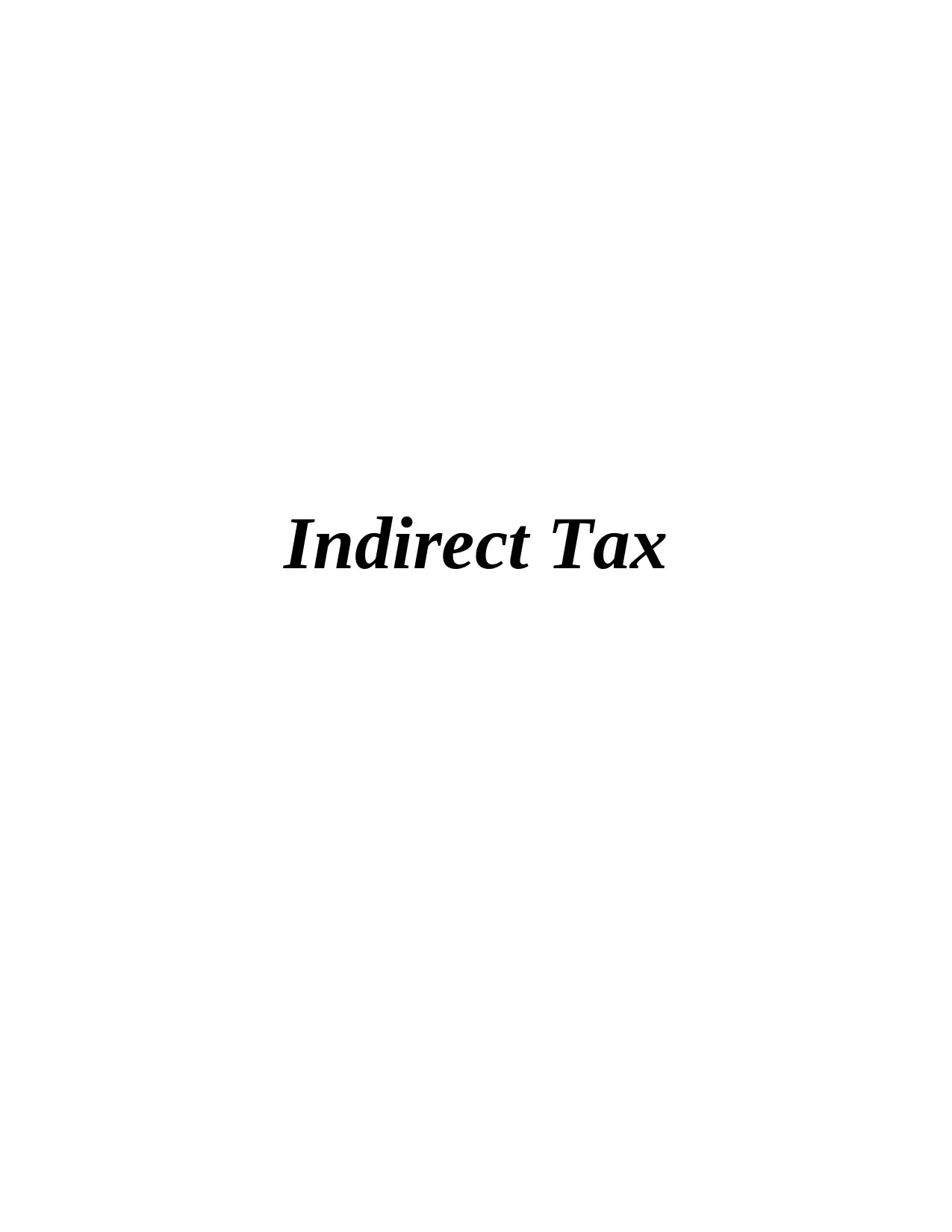
Indirect Tax
Paraphrase This Document
Need a fresh take? Get an instant paraphrase of this document with our AI Paraphraser
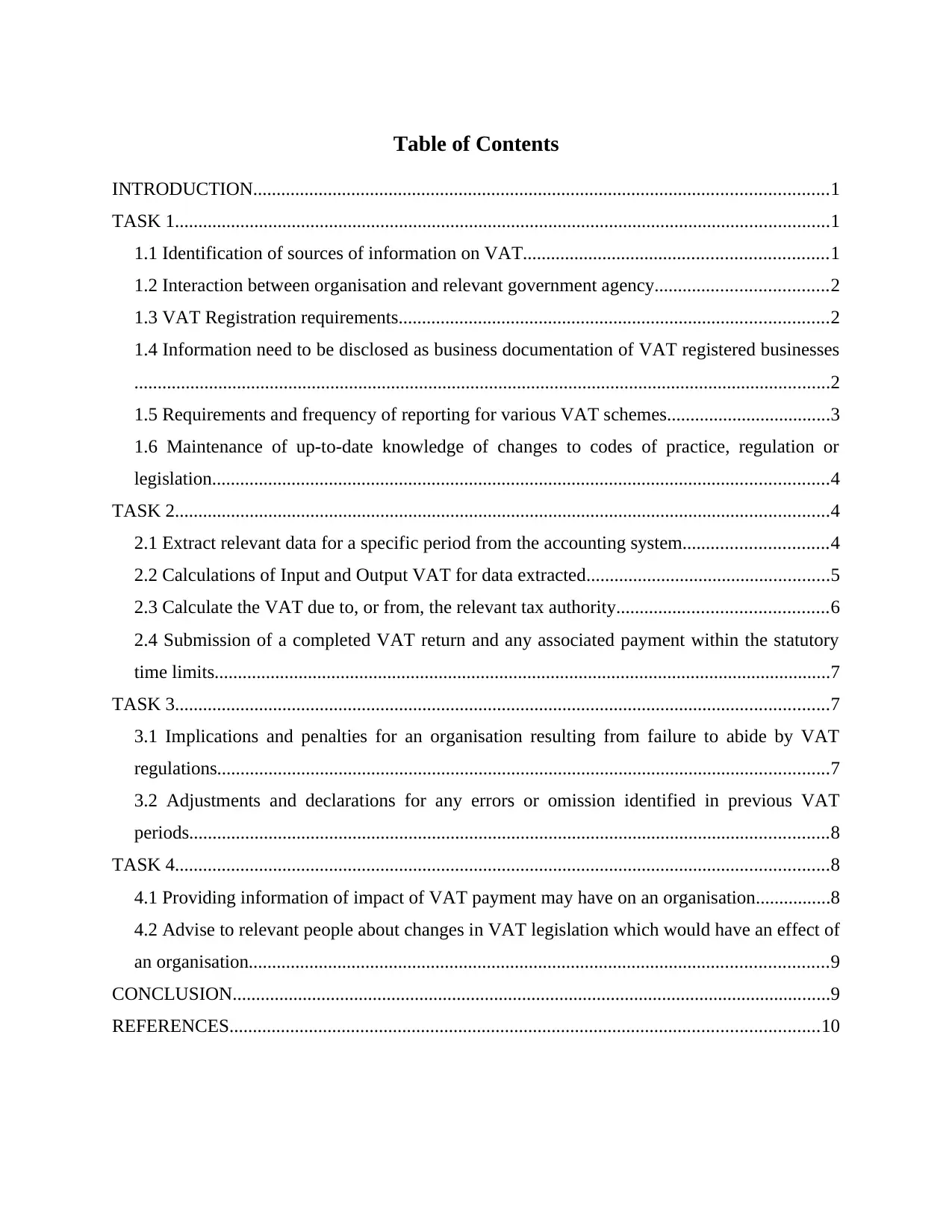
Table of Contents
INTRODUCTION...........................................................................................................................1
TASK 1............................................................................................................................................1
1.1 Identification of sources of information on VAT.................................................................1
1.2 Interaction between organisation and relevant government agency.....................................2
1.3 VAT Registration requirements............................................................................................2
1.4 Information need to be disclosed as business documentation of VAT registered businesses
.....................................................................................................................................................2
1.5 Requirements and frequency of reporting for various VAT schemes...................................3
1.6 Maintenance of up-to-date knowledge of changes to codes of practice, regulation or
legislation....................................................................................................................................4
TASK 2............................................................................................................................................4
2.1 Extract relevant data for a specific period from the accounting system...............................4
2.2 Calculations of Input and Output VAT for data extracted....................................................5
2.3 Calculate the VAT due to, or from, the relevant tax authority.............................................6
2.4 Submission of a completed VAT return and any associated payment within the statutory
time limits....................................................................................................................................7
TASK 3............................................................................................................................................7
3.1 Implications and penalties for an organisation resulting from failure to abide by VAT
regulations...................................................................................................................................7
3.2 Adjustments and declarations for any errors or omission identified in previous VAT
periods.........................................................................................................................................8
TASK 4............................................................................................................................................8
4.1 Providing information of impact of VAT payment may have on an organisation................8
4.2 Advise to relevant people about changes in VAT legislation which would have an effect of
an organisation............................................................................................................................9
CONCLUSION................................................................................................................................9
REFERENCES..............................................................................................................................10
INTRODUCTION...........................................................................................................................1
TASK 1............................................................................................................................................1
1.1 Identification of sources of information on VAT.................................................................1
1.2 Interaction between organisation and relevant government agency.....................................2
1.3 VAT Registration requirements............................................................................................2
1.4 Information need to be disclosed as business documentation of VAT registered businesses
.....................................................................................................................................................2
1.5 Requirements and frequency of reporting for various VAT schemes...................................3
1.6 Maintenance of up-to-date knowledge of changes to codes of practice, regulation or
legislation....................................................................................................................................4
TASK 2............................................................................................................................................4
2.1 Extract relevant data for a specific period from the accounting system...............................4
2.2 Calculations of Input and Output VAT for data extracted....................................................5
2.3 Calculate the VAT due to, or from, the relevant tax authority.............................................6
2.4 Submission of a completed VAT return and any associated payment within the statutory
time limits....................................................................................................................................7
TASK 3............................................................................................................................................7
3.1 Implications and penalties for an organisation resulting from failure to abide by VAT
regulations...................................................................................................................................7
3.2 Adjustments and declarations for any errors or omission identified in previous VAT
periods.........................................................................................................................................8
TASK 4............................................................................................................................................8
4.1 Providing information of impact of VAT payment may have on an organisation................8
4.2 Advise to relevant people about changes in VAT legislation which would have an effect of
an organisation............................................................................................................................9
CONCLUSION................................................................................................................................9
REFERENCES..............................................................................................................................10
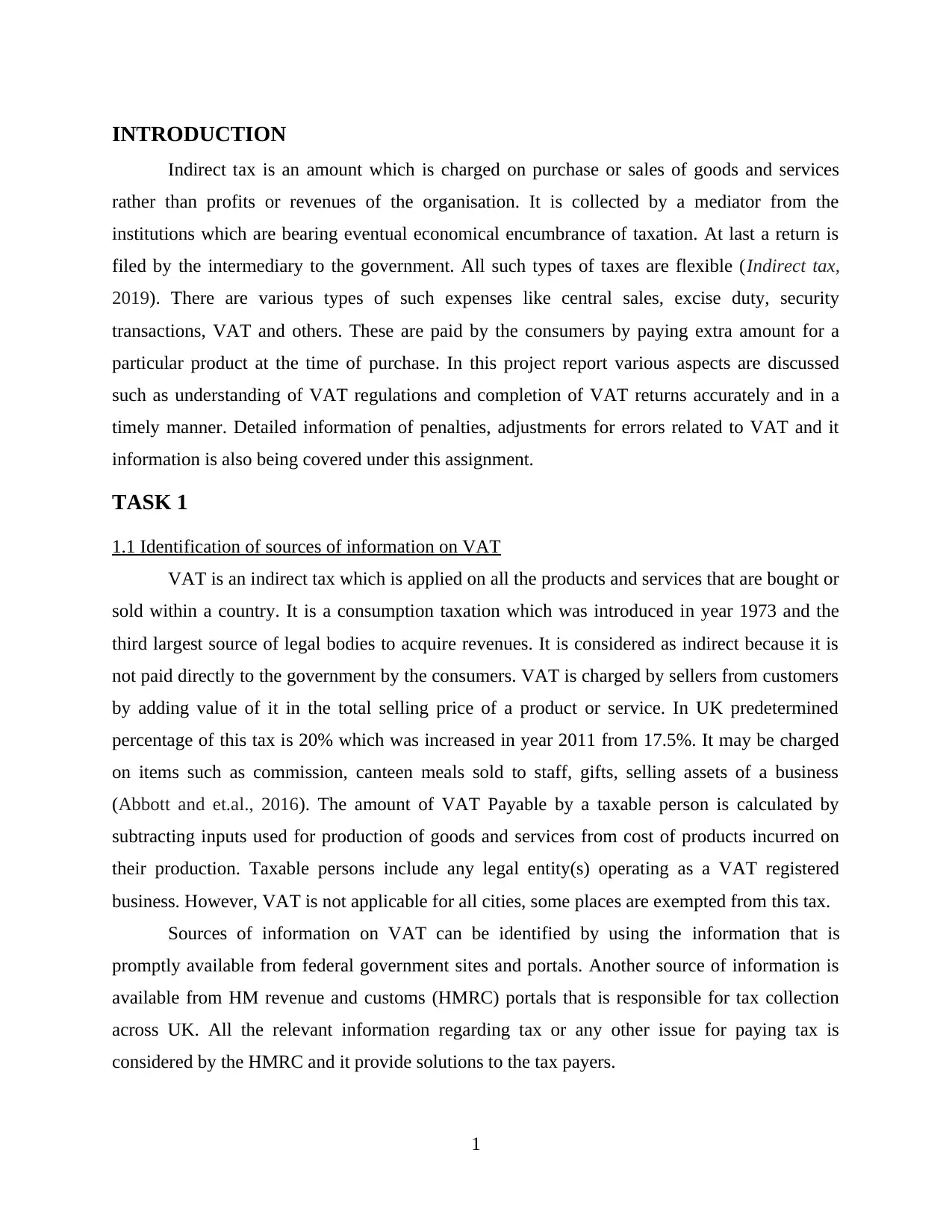
INTRODUCTION
Indirect tax is an amount which is charged on purchase or sales of goods and services
rather than profits or revenues of the organisation. It is collected by a mediator from the
institutions which are bearing eventual economical encumbrance of taxation. At last a return is
filed by the intermediary to the government. All such types of taxes are flexible (Indirect tax,
2019). There are various types of such expenses like central sales, excise duty, security
transactions, VAT and others. These are paid by the consumers by paying extra amount for a
particular product at the time of purchase. In this project report various aspects are discussed
such as understanding of VAT regulations and completion of VAT returns accurately and in a
timely manner. Detailed information of penalties, adjustments for errors related to VAT and it
information is also being covered under this assignment.
TASK 1
1.1 Identification of sources of information on VAT
VAT is an indirect tax which is applied on all the products and services that are bought or
sold within a country. It is a consumption taxation which was introduced in year 1973 and the
third largest source of legal bodies to acquire revenues. It is considered as indirect because it is
not paid directly to the government by the consumers. VAT is charged by sellers from customers
by adding value of it in the total selling price of a product or service. In UK predetermined
percentage of this tax is 20% which was increased in year 2011 from 17.5%. It may be charged
on items such as commission, canteen meals sold to staff, gifts, selling assets of a business
(Abbott and et.al., 2016). The amount of VAT Payable by a taxable person is calculated by
subtracting inputs used for production of goods and services from cost of products incurred on
their production. Taxable persons include any legal entity(s) operating as a VAT registered
business. However, VAT is not applicable for all cities, some places are exempted from this tax.
Sources of information on VAT can be identified by using the information that is
promptly available from federal government sites and portals. Another source of information is
available from HM revenue and customs (HMRC) portals that is responsible for tax collection
across UK. All the relevant information regarding tax or any other issue for paying tax is
considered by the HMRC and it provide solutions to the tax payers.
1
Indirect tax is an amount which is charged on purchase or sales of goods and services
rather than profits or revenues of the organisation. It is collected by a mediator from the
institutions which are bearing eventual economical encumbrance of taxation. At last a return is
filed by the intermediary to the government. All such types of taxes are flexible (Indirect tax,
2019). There are various types of such expenses like central sales, excise duty, security
transactions, VAT and others. These are paid by the consumers by paying extra amount for a
particular product at the time of purchase. In this project report various aspects are discussed
such as understanding of VAT regulations and completion of VAT returns accurately and in a
timely manner. Detailed information of penalties, adjustments for errors related to VAT and it
information is also being covered under this assignment.
TASK 1
1.1 Identification of sources of information on VAT
VAT is an indirect tax which is applied on all the products and services that are bought or
sold within a country. It is a consumption taxation which was introduced in year 1973 and the
third largest source of legal bodies to acquire revenues. It is considered as indirect because it is
not paid directly to the government by the consumers. VAT is charged by sellers from customers
by adding value of it in the total selling price of a product or service. In UK predetermined
percentage of this tax is 20% which was increased in year 2011 from 17.5%. It may be charged
on items such as commission, canteen meals sold to staff, gifts, selling assets of a business
(Abbott and et.al., 2016). The amount of VAT Payable by a taxable person is calculated by
subtracting inputs used for production of goods and services from cost of products incurred on
their production. Taxable persons include any legal entity(s) operating as a VAT registered
business. However, VAT is not applicable for all cities, some places are exempted from this tax.
Sources of information on VAT can be identified by using the information that is
promptly available from federal government sites and portals. Another source of information is
available from HM revenue and customs (HMRC) portals that is responsible for tax collection
across UK. All the relevant information regarding tax or any other issue for paying tax is
considered by the HMRC and it provide solutions to the tax payers.
1
⊘ This is a preview!⊘
Do you want full access?
Subscribe today to unlock all pages.

Trusted by 1+ million students worldwide
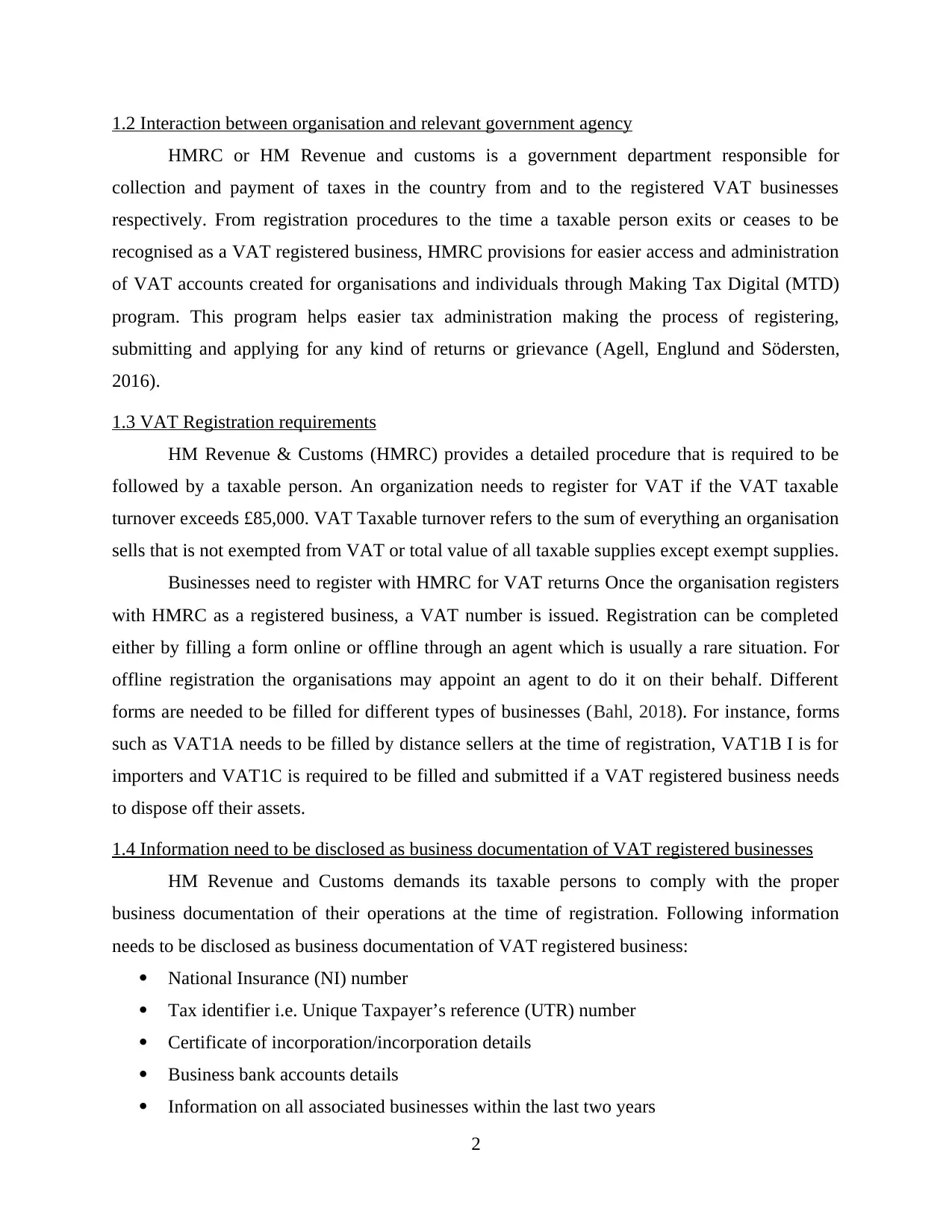
1.2 Interaction between organisation and relevant government agency
HMRC or HM Revenue and customs is a government department responsible for
collection and payment of taxes in the country from and to the registered VAT businesses
respectively. From registration procedures to the time a taxable person exits or ceases to be
recognised as a VAT registered business, HMRC provisions for easier access and administration
of VAT accounts created for organisations and individuals through Making Tax Digital (MTD)
program. This program helps easier tax administration making the process of registering,
submitting and applying for any kind of returns or grievance (Agell, Englund and Södersten,
2016).
1.3 VAT Registration requirements
HM Revenue & Customs (HMRC) provides a detailed procedure that is required to be
followed by a taxable person. An organization needs to register for VAT if the VAT taxable
turnover exceeds £85,000. VAT Taxable turnover refers to the sum of everything an organisation
sells that is not exempted from VAT or total value of all taxable supplies except exempt supplies.
Businesses need to register with HMRC for VAT returns Once the organisation registers
with HMRC as a registered business, a VAT number is issued. Registration can be completed
either by filling a form online or offline through an agent which is usually a rare situation. For
offline registration the organisations may appoint an agent to do it on their behalf. Different
forms are needed to be filled for different types of businesses (Bahl, 2018). For instance, forms
such as VAT1A needs to be filled by distance sellers at the time of registration, VAT1B I is for
importers and VAT1C is required to be filled and submitted if a VAT registered business needs
to dispose off their assets.
1.4 Information need to be disclosed as business documentation of VAT registered businesses
HM Revenue and Customs demands its taxable persons to comply with the proper
business documentation of their operations at the time of registration. Following information
needs to be disclosed as business documentation of VAT registered business:
National Insurance (NI) number
Tax identifier i.e. Unique Taxpayer’s reference (UTR) number
Certificate of incorporation/incorporation details
Business bank accounts details
Information on all associated businesses within the last two years
2
HMRC or HM Revenue and customs is a government department responsible for
collection and payment of taxes in the country from and to the registered VAT businesses
respectively. From registration procedures to the time a taxable person exits or ceases to be
recognised as a VAT registered business, HMRC provisions for easier access and administration
of VAT accounts created for organisations and individuals through Making Tax Digital (MTD)
program. This program helps easier tax administration making the process of registering,
submitting and applying for any kind of returns or grievance (Agell, Englund and Södersten,
2016).
1.3 VAT Registration requirements
HM Revenue & Customs (HMRC) provides a detailed procedure that is required to be
followed by a taxable person. An organization needs to register for VAT if the VAT taxable
turnover exceeds £85,000. VAT Taxable turnover refers to the sum of everything an organisation
sells that is not exempted from VAT or total value of all taxable supplies except exempt supplies.
Businesses need to register with HMRC for VAT returns Once the organisation registers
with HMRC as a registered business, a VAT number is issued. Registration can be completed
either by filling a form online or offline through an agent which is usually a rare situation. For
offline registration the organisations may appoint an agent to do it on their behalf. Different
forms are needed to be filled for different types of businesses (Bahl, 2018). For instance, forms
such as VAT1A needs to be filled by distance sellers at the time of registration, VAT1B I is for
importers and VAT1C is required to be filled and submitted if a VAT registered business needs
to dispose off their assets.
1.4 Information need to be disclosed as business documentation of VAT registered businesses
HM Revenue and Customs demands its taxable persons to comply with the proper
business documentation of their operations at the time of registration. Following information
needs to be disclosed as business documentation of VAT registered business:
National Insurance (NI) number
Tax identifier i.e. Unique Taxpayer’s reference (UTR) number
Certificate of incorporation/incorporation details
Business bank accounts details
Information on all associated businesses within the last two years
2
Paraphrase This Document
Need a fresh take? Get an instant paraphrase of this document with our AI Paraphraser
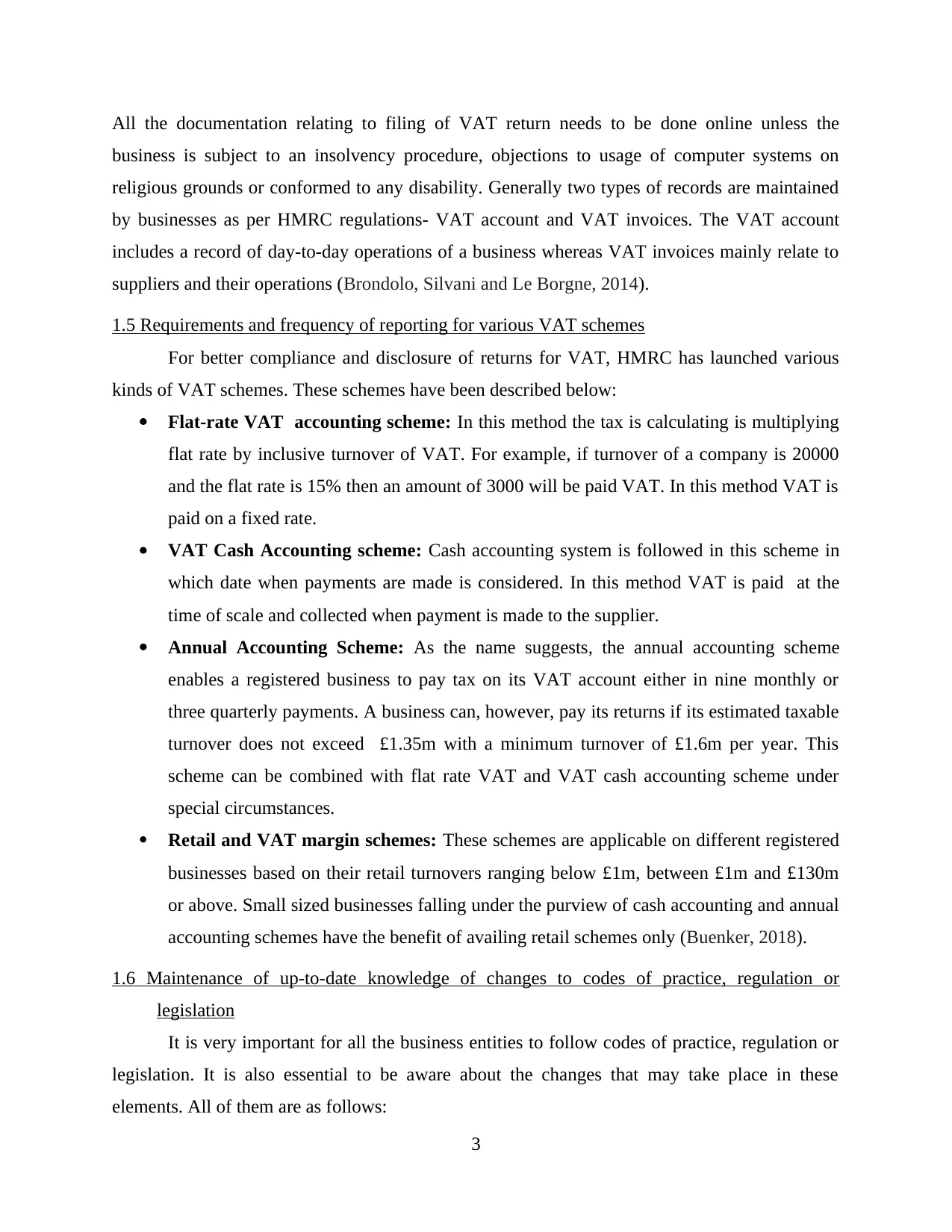
All the documentation relating to filing of VAT return needs to be done online unless the
business is subject to an insolvency procedure, objections to usage of computer systems on
religious grounds or conformed to any disability. Generally two types of records are maintained
by businesses as per HMRC regulations- VAT account and VAT invoices. The VAT account
includes a record of day-to-day operations of a business whereas VAT invoices mainly relate to
suppliers and their operations (Brondolo, Silvani and Le Borgne, 2014).
1.5 Requirements and frequency of reporting for various VAT schemes
For better compliance and disclosure of returns for VAT, HMRC has launched various
kinds of VAT schemes. These schemes have been described below:
Flat-rate VAT accounting scheme: In this method the tax is calculating is multiplying
flat rate by inclusive turnover of VAT. For example, if turnover of a company is 20000
and the flat rate is 15% then an amount of 3000 will be paid VAT. In this method VAT is
paid on a fixed rate.
VAT Cash Accounting scheme: Cash accounting system is followed in this scheme in
which date when payments are made is considered. In this method VAT is paid at the
time of scale and collected when payment is made to the supplier.
Annual Accounting Scheme: As the name suggests, the annual accounting scheme
enables a registered business to pay tax on its VAT account either in nine monthly or
three quarterly payments. A business can, however, pay its returns if its estimated taxable
turnover does not exceed £1.35m with a minimum turnover of £1.6m per year. This
scheme can be combined with flat rate VAT and VAT cash accounting scheme under
special circumstances.
Retail and VAT margin schemes: These schemes are applicable on different registered
businesses based on their retail turnovers ranging below £1m, between £1m and £130m
or above. Small sized businesses falling under the purview of cash accounting and annual
accounting schemes have the benefit of availing retail schemes only (Buenker, 2018).
1.6 Maintenance of up-to-date knowledge of changes to codes of practice, regulation or
legislation
It is very important for all the business entities to follow codes of practice, regulation or
legislation. It is also essential to be aware about the changes that may take place in these
elements. All of them are as follows:
3
business is subject to an insolvency procedure, objections to usage of computer systems on
religious grounds or conformed to any disability. Generally two types of records are maintained
by businesses as per HMRC regulations- VAT account and VAT invoices. The VAT account
includes a record of day-to-day operations of a business whereas VAT invoices mainly relate to
suppliers and their operations (Brondolo, Silvani and Le Borgne, 2014).
1.5 Requirements and frequency of reporting for various VAT schemes
For better compliance and disclosure of returns for VAT, HMRC has launched various
kinds of VAT schemes. These schemes have been described below:
Flat-rate VAT accounting scheme: In this method the tax is calculating is multiplying
flat rate by inclusive turnover of VAT. For example, if turnover of a company is 20000
and the flat rate is 15% then an amount of 3000 will be paid VAT. In this method VAT is
paid on a fixed rate.
VAT Cash Accounting scheme: Cash accounting system is followed in this scheme in
which date when payments are made is considered. In this method VAT is paid at the
time of scale and collected when payment is made to the supplier.
Annual Accounting Scheme: As the name suggests, the annual accounting scheme
enables a registered business to pay tax on its VAT account either in nine monthly or
three quarterly payments. A business can, however, pay its returns if its estimated taxable
turnover does not exceed £1.35m with a minimum turnover of £1.6m per year. This
scheme can be combined with flat rate VAT and VAT cash accounting scheme under
special circumstances.
Retail and VAT margin schemes: These schemes are applicable on different registered
businesses based on their retail turnovers ranging below £1m, between £1m and £130m
or above. Small sized businesses falling under the purview of cash accounting and annual
accounting schemes have the benefit of availing retail schemes only (Buenker, 2018).
1.6 Maintenance of up-to-date knowledge of changes to codes of practice, regulation or
legislation
It is very important for all the business entities to follow codes of practice, regulation or
legislation. It is also essential to be aware about the changes that may take place in these
elements. All of them are as follows:
3
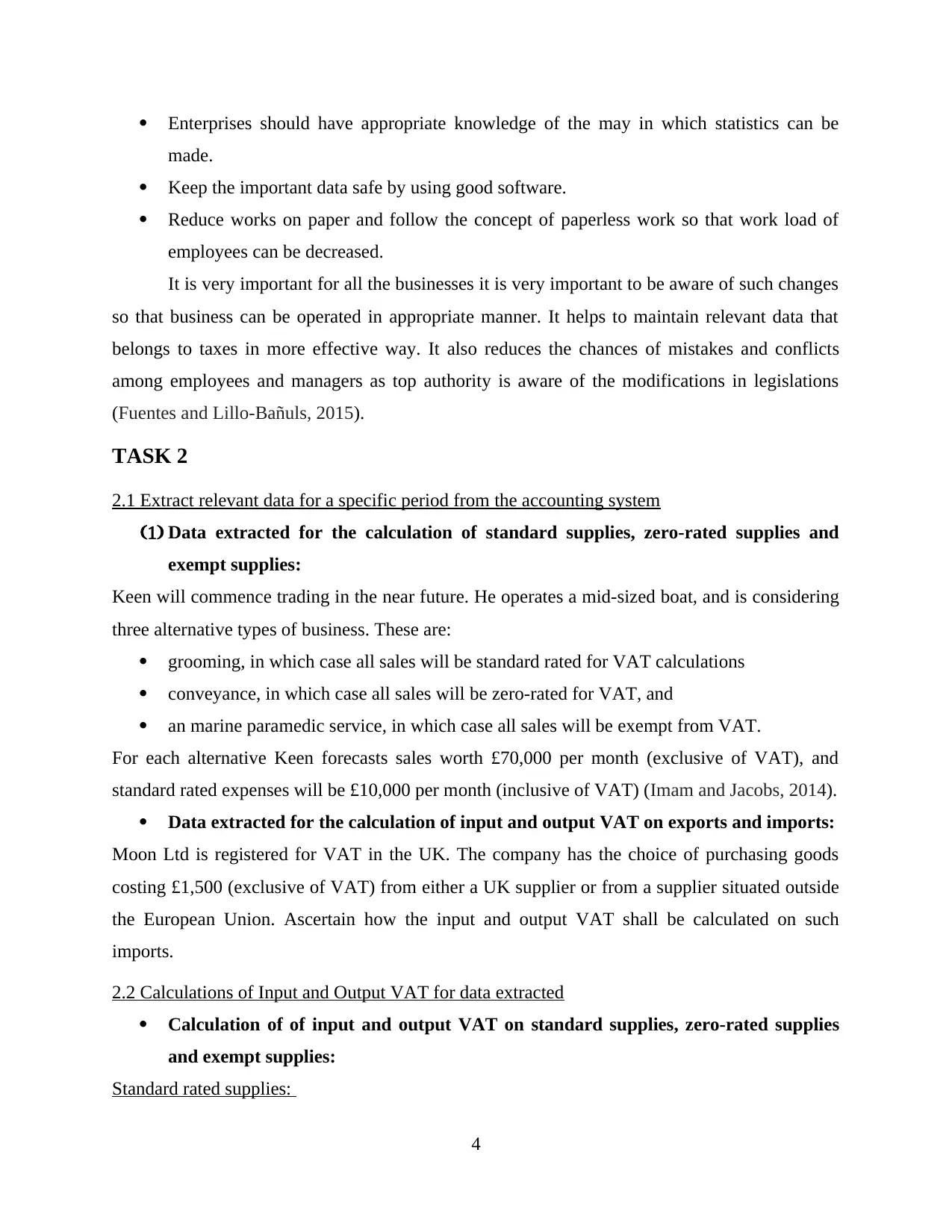
Enterprises should have appropriate knowledge of the may in which statistics can be
made.
Keep the important data safe by using good software.
Reduce works on paper and follow the concept of paperless work so that work load of
employees can be decreased.
It is very important for all the businesses it is very important to be aware of such changes
so that business can be operated in appropriate manner. It helps to maintain relevant data that
belongs to taxes in more effective way. It also reduces the chances of mistakes and conflicts
among employees and managers as top authority is aware of the modifications in legislations
(Fuentes and Lillo-Bañuls, 2015).
TASK 2
2.1 Extract relevant data for a specific period from the accounting system
(1) Data extracted for the calculation of standard supplies, zero-rated supplies and
exempt supplies:
Keen will commence trading in the near future. He operates a mid-sized boat, and is considering
three alternative types of business. These are:
grooming, in which case all sales will be standard rated for VAT calculations
conveyance, in which case all sales will be zero-rated for VAT, and
an marine paramedic service, in which case all sales will be exempt from VAT.
For each alternative Keen forecasts sales worth £70,000 per month (exclusive of VAT), and
standard rated expenses will be £10,000 per month (inclusive of VAT) (Imam and Jacobs, 2014).
Data extracted for the calculation of input and output VAT on exports and imports:
Moon Ltd is registered for VAT in the UK. The company has the choice of purchasing goods
costing £1,500 (exclusive of VAT) from either a UK supplier or from a supplier situated outside
the European Union. Ascertain how the input and output VAT shall be calculated on such
imports.
2.2 Calculations of Input and Output VAT for data extracted
Calculation of of input and output VAT on standard supplies, zero-rated supplies
and exempt supplies:
Standard rated supplies:
4
made.
Keep the important data safe by using good software.
Reduce works on paper and follow the concept of paperless work so that work load of
employees can be decreased.
It is very important for all the businesses it is very important to be aware of such changes
so that business can be operated in appropriate manner. It helps to maintain relevant data that
belongs to taxes in more effective way. It also reduces the chances of mistakes and conflicts
among employees and managers as top authority is aware of the modifications in legislations
(Fuentes and Lillo-Bañuls, 2015).
TASK 2
2.1 Extract relevant data for a specific period from the accounting system
(1) Data extracted for the calculation of standard supplies, zero-rated supplies and
exempt supplies:
Keen will commence trading in the near future. He operates a mid-sized boat, and is considering
three alternative types of business. These are:
grooming, in which case all sales will be standard rated for VAT calculations
conveyance, in which case all sales will be zero-rated for VAT, and
an marine paramedic service, in which case all sales will be exempt from VAT.
For each alternative Keen forecasts sales worth £70,000 per month (exclusive of VAT), and
standard rated expenses will be £10,000 per month (inclusive of VAT) (Imam and Jacobs, 2014).
Data extracted for the calculation of input and output VAT on exports and imports:
Moon Ltd is registered for VAT in the UK. The company has the choice of purchasing goods
costing £1,500 (exclusive of VAT) from either a UK supplier or from a supplier situated outside
the European Union. Ascertain how the input and output VAT shall be calculated on such
imports.
2.2 Calculations of Input and Output VAT for data extracted
Calculation of of input and output VAT on standard supplies, zero-rated supplies
and exempt supplies:
Standard rated supplies:
4
⊘ This is a preview!⊘
Do you want full access?
Subscribe today to unlock all pages.

Trusted by 1+ million students worldwide
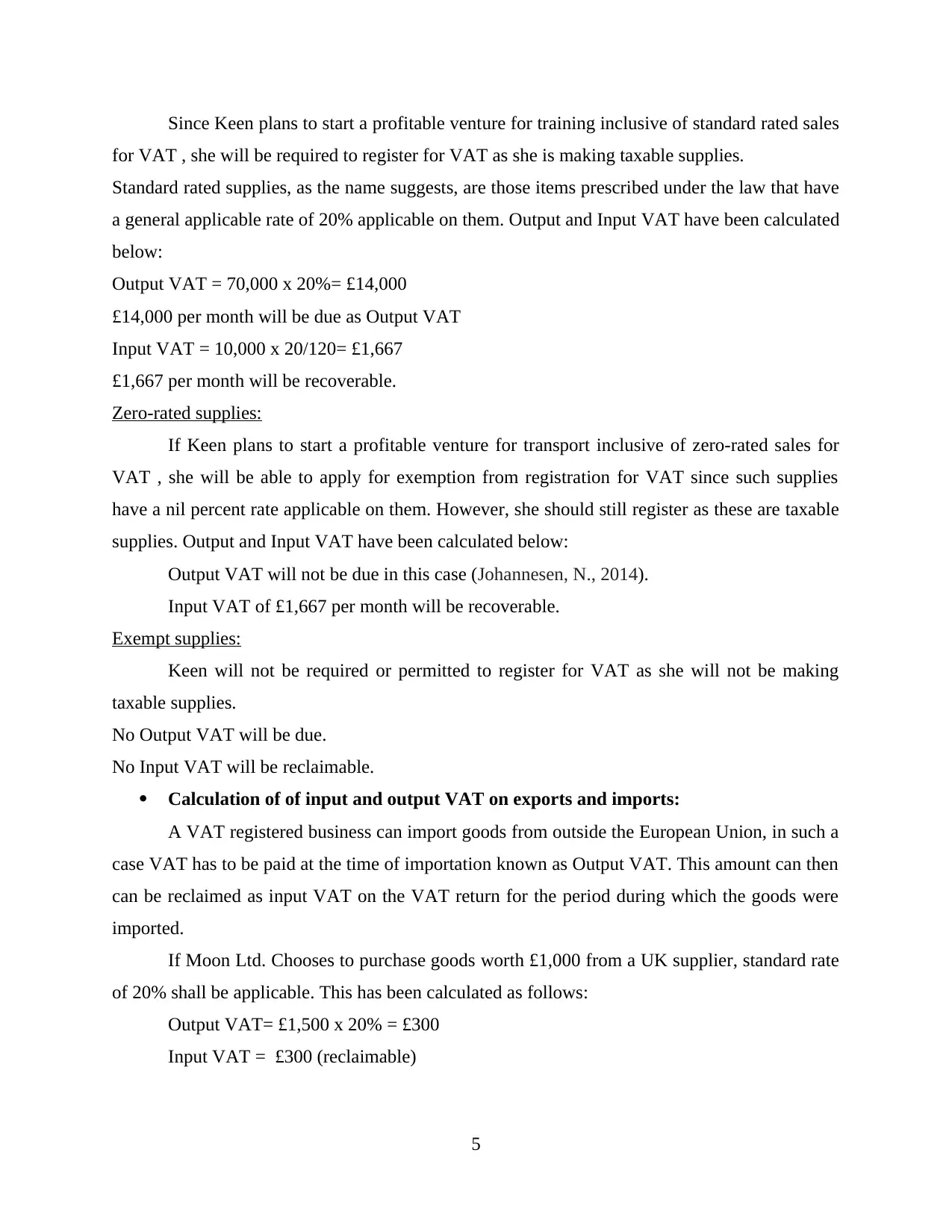
Since Keen plans to start a profitable venture for training inclusive of standard rated sales
for VAT , she will be required to register for VAT as she is making taxable supplies.
Standard rated supplies, as the name suggests, are those items prescribed under the law that have
a general applicable rate of 20% applicable on them. Output and Input VAT have been calculated
below:
Output VAT = 70,000 x 20%= £14,000
£14,000 per month will be due as Output VAT
Input VAT = 10,000 x 20/120= £1,667
£1,667 per month will be recoverable.
Zero-rated supplies:
If Keen plans to start a profitable venture for transport inclusive of zero-rated sales for
VAT , she will be able to apply for exemption from registration for VAT since such supplies
have a nil percent rate applicable on them. However, she should still register as these are taxable
supplies. Output and Input VAT have been calculated below:
Output VAT will not be due in this case (Johannesen, N., 2014).
Input VAT of £1,667 per month will be recoverable.
Exempt supplies:
Keen will not be required or permitted to register for VAT as she will not be making
taxable supplies.
No Output VAT will be due.
No Input VAT will be reclaimable.
Calculation of of input and output VAT on exports and imports:
A VAT registered business can import goods from outside the European Union, in such a
case VAT has to be paid at the time of importation known as Output VAT. This amount can then
can be reclaimed as input VAT on the VAT return for the period during which the goods were
imported.
If Moon Ltd. Chooses to purchase goods worth £1,000 from a UK supplier, standard rate
of 20% shall be applicable. This has been calculated as follows:
Output VAT= £1,500 x 20% = £300
Input VAT = £300 (reclaimable)
5
for VAT , she will be required to register for VAT as she is making taxable supplies.
Standard rated supplies, as the name suggests, are those items prescribed under the law that have
a general applicable rate of 20% applicable on them. Output and Input VAT have been calculated
below:
Output VAT = 70,000 x 20%= £14,000
£14,000 per month will be due as Output VAT
Input VAT = 10,000 x 20/120= £1,667
£1,667 per month will be recoverable.
Zero-rated supplies:
If Keen plans to start a profitable venture for transport inclusive of zero-rated sales for
VAT , she will be able to apply for exemption from registration for VAT since such supplies
have a nil percent rate applicable on them. However, she should still register as these are taxable
supplies. Output and Input VAT have been calculated below:
Output VAT will not be due in this case (Johannesen, N., 2014).
Input VAT of £1,667 per month will be recoverable.
Exempt supplies:
Keen will not be required or permitted to register for VAT as she will not be making
taxable supplies.
No Output VAT will be due.
No Input VAT will be reclaimable.
Calculation of of input and output VAT on exports and imports:
A VAT registered business can import goods from outside the European Union, in such a
case VAT has to be paid at the time of importation known as Output VAT. This amount can then
can be reclaimed as input VAT on the VAT return for the period during which the goods were
imported.
If Moon Ltd. Chooses to purchase goods worth £1,000 from a UK supplier, standard rate
of 20% shall be applicable. This has been calculated as follows:
Output VAT= £1,500 x 20% = £300
Input VAT = £300 (reclaimable)
5
Paraphrase This Document
Need a fresh take? Get an instant paraphrase of this document with our AI Paraphraser
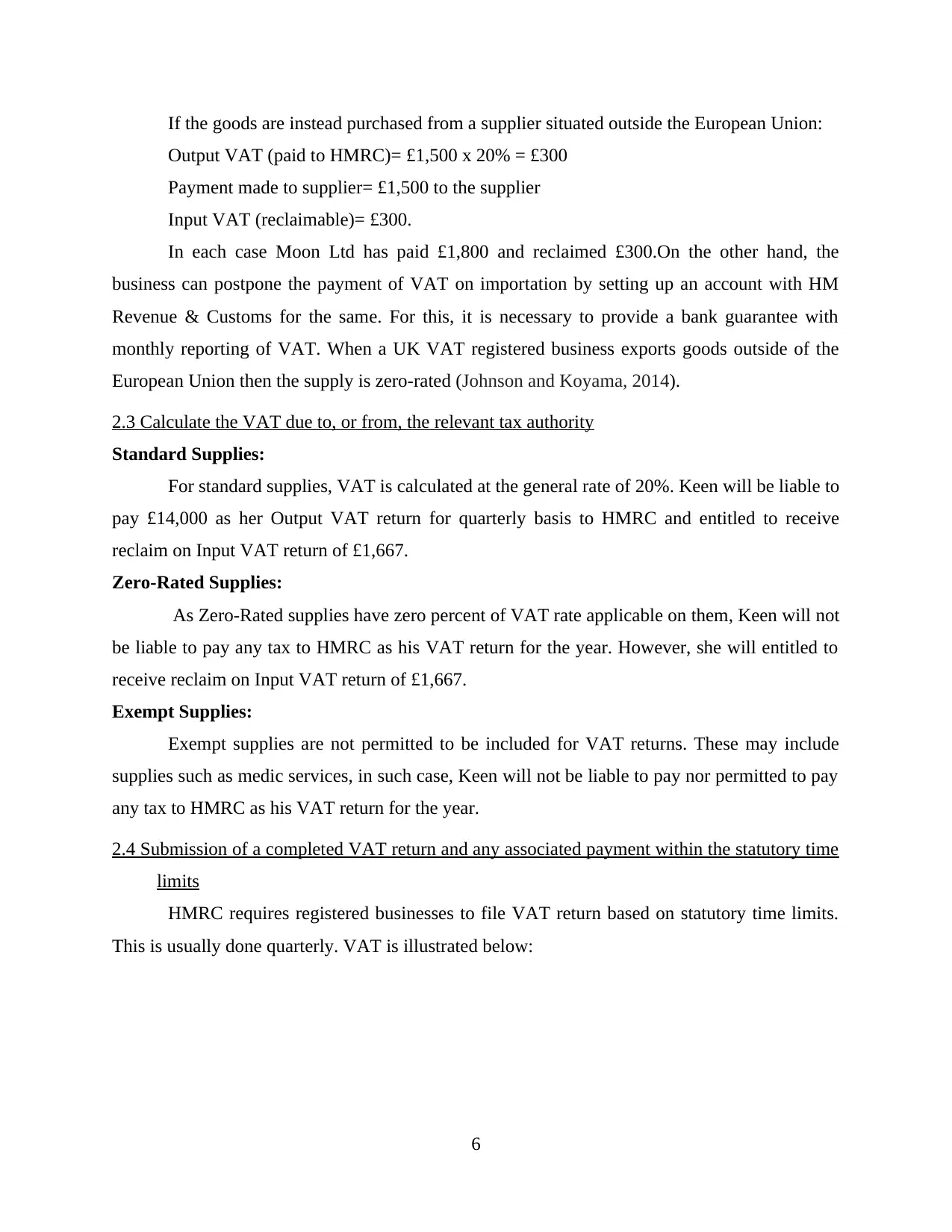
If the goods are instead purchased from a supplier situated outside the European Union:
Output VAT (paid to HMRC)= £1,500 x 20% = £300
Payment made to supplier= £1,500 to the supplier
Input VAT (reclaimable)= £300.
In each case Moon Ltd has paid £1,800 and reclaimed £300.On the other hand, the
business can postpone the payment of VAT on importation by setting up an account with HM
Revenue & Customs for the same. For this, it is necessary to provide a bank guarantee with
monthly reporting of VAT. When a UK VAT registered business exports goods outside of the
European Union then the supply is zero-rated (Johnson and Koyama, 2014).
2.3 Calculate the VAT due to, or from, the relevant tax authority
Standard Supplies:
For standard supplies, VAT is calculated at the general rate of 20%. Keen will be liable to
pay £14,000 as her Output VAT return for quarterly basis to HMRC and entitled to receive
reclaim on Input VAT return of £1,667.
Zero-Rated Supplies:
As Zero-Rated supplies have zero percent of VAT rate applicable on them, Keen will not
be liable to pay any tax to HMRC as his VAT return for the year. However, she will entitled to
receive reclaim on Input VAT return of £1,667.
Exempt Supplies:
Exempt supplies are not permitted to be included for VAT returns. These may include
supplies such as medic services, in such case, Keen will not be liable to pay nor permitted to pay
any tax to HMRC as his VAT return for the year.
2.4 Submission of a completed VAT return and any associated payment within the statutory time
limits
HMRC requires registered businesses to file VAT return based on statutory time limits.
This is usually done quarterly. VAT is illustrated below:
6
Output VAT (paid to HMRC)= £1,500 x 20% = £300
Payment made to supplier= £1,500 to the supplier
Input VAT (reclaimable)= £300.
In each case Moon Ltd has paid £1,800 and reclaimed £300.On the other hand, the
business can postpone the payment of VAT on importation by setting up an account with HM
Revenue & Customs for the same. For this, it is necessary to provide a bank guarantee with
monthly reporting of VAT. When a UK VAT registered business exports goods outside of the
European Union then the supply is zero-rated (Johnson and Koyama, 2014).
2.3 Calculate the VAT due to, or from, the relevant tax authority
Standard Supplies:
For standard supplies, VAT is calculated at the general rate of 20%. Keen will be liable to
pay £14,000 as her Output VAT return for quarterly basis to HMRC and entitled to receive
reclaim on Input VAT return of £1,667.
Zero-Rated Supplies:
As Zero-Rated supplies have zero percent of VAT rate applicable on them, Keen will not
be liable to pay any tax to HMRC as his VAT return for the year. However, she will entitled to
receive reclaim on Input VAT return of £1,667.
Exempt Supplies:
Exempt supplies are not permitted to be included for VAT returns. These may include
supplies such as medic services, in such case, Keen will not be liable to pay nor permitted to pay
any tax to HMRC as his VAT return for the year.
2.4 Submission of a completed VAT return and any associated payment within the statutory time
limits
HMRC requires registered businesses to file VAT return based on statutory time limits.
This is usually done quarterly. VAT is illustrated below:
6
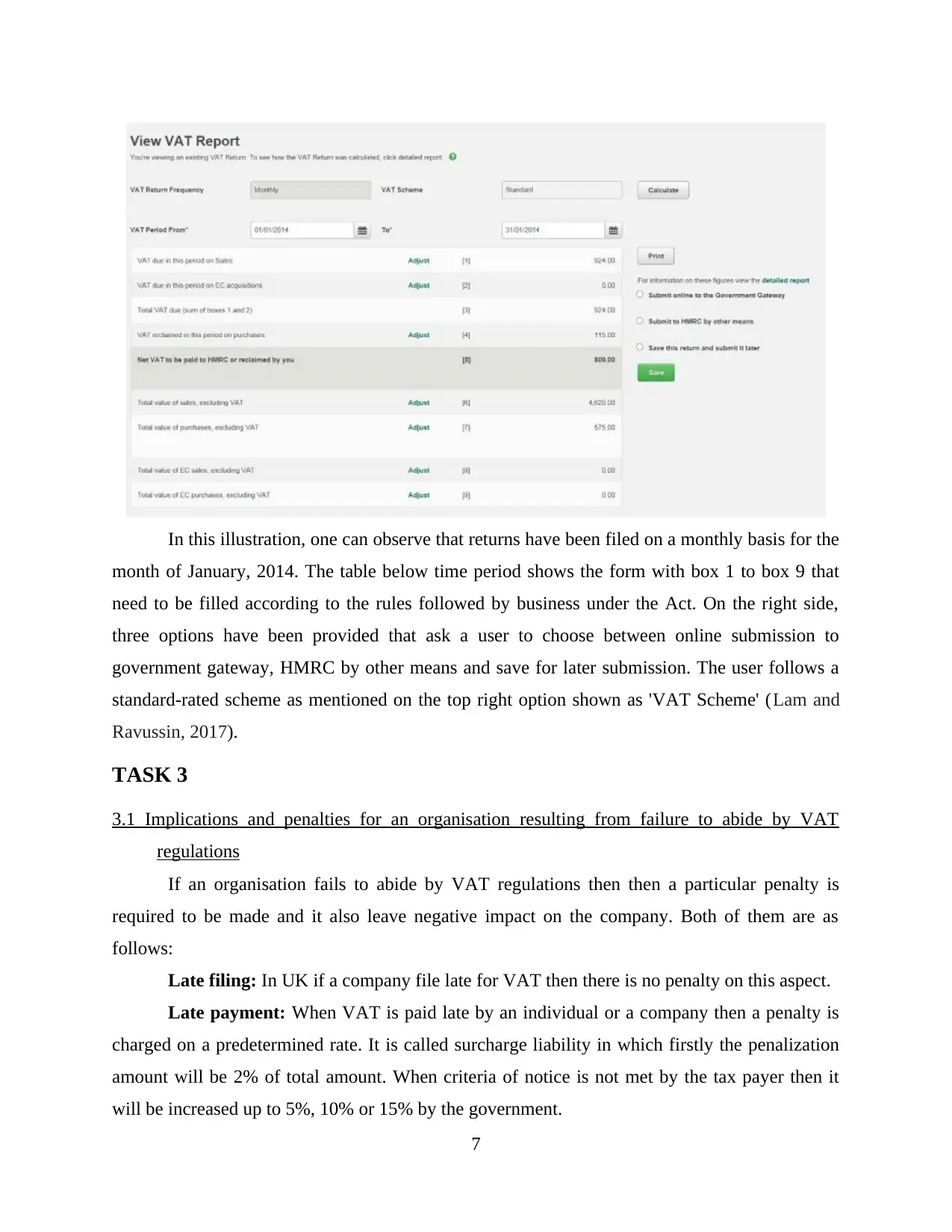
In this illustration, one can observe that returns have been filed on a monthly basis for the
month of January, 2014. The table below time period shows the form with box 1 to box 9 that
need to be filled according to the rules followed by business under the Act. On the right side,
three options have been provided that ask a user to choose between online submission to
government gateway, HMRC by other means and save for later submission. The user follows a
standard-rated scheme as mentioned on the top right option shown as 'VAT Scheme' (Lam and
Ravussin, 2017).
TASK 3
3.1 Implications and penalties for an organisation resulting from failure to abide by VAT
regulations
If an organisation fails to abide by VAT regulations then then a particular penalty is
required to be made and it also leave negative impact on the company. Both of them are as
follows:
Late filing: In UK if a company file late for VAT then there is no penalty on this aspect.
Late payment: When VAT is paid late by an individual or a company then a penalty is
charged on a predetermined rate. It is called surcharge liability in which firstly the penalization
amount will be 2% of total amount. When criteria of notice is not met by the tax payer then it
will be increased up to 5%, 10% or 15% by the government.
7
month of January, 2014. The table below time period shows the form with box 1 to box 9 that
need to be filled according to the rules followed by business under the Act. On the right side,
three options have been provided that ask a user to choose between online submission to
government gateway, HMRC by other means and save for later submission. The user follows a
standard-rated scheme as mentioned on the top right option shown as 'VAT Scheme' (Lam and
Ravussin, 2017).
TASK 3
3.1 Implications and penalties for an organisation resulting from failure to abide by VAT
regulations
If an organisation fails to abide by VAT regulations then then a particular penalty is
required to be made and it also leave negative impact on the company. Both of them are as
follows:
Late filing: In UK if a company file late for VAT then there is no penalty on this aspect.
Late payment: When VAT is paid late by an individual or a company then a penalty is
charged on a predetermined rate. It is called surcharge liability in which firstly the penalization
amount will be 2% of total amount. When criteria of notice is not met by the tax payer then it
will be increased up to 5%, 10% or 15% by the government.
7
⊘ This is a preview!⊘
Do you want full access?
Subscribe today to unlock all pages.

Trusted by 1+ million students worldwide
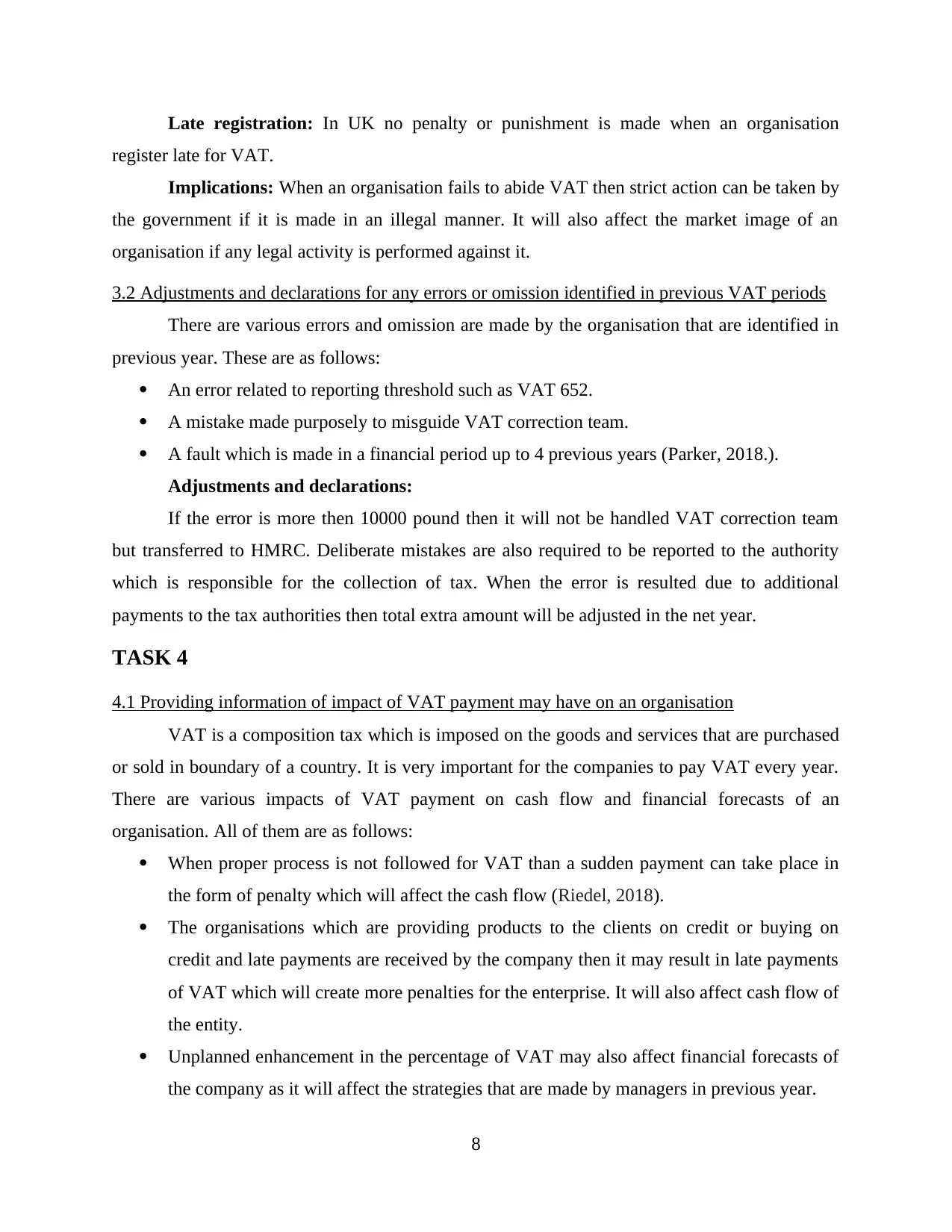
Late registration: In UK no penalty or punishment is made when an organisation
register late for VAT.
Implications: When an organisation fails to abide VAT then strict action can be taken by
the government if it is made in an illegal manner. It will also affect the market image of an
organisation if any legal activity is performed against it.
3.2 Adjustments and declarations for any errors or omission identified in previous VAT periods
There are various errors and omission are made by the organisation that are identified in
previous year. These are as follows:
An error related to reporting threshold such as VAT 652.
A mistake made purposely to misguide VAT correction team.
A fault which is made in a financial period up to 4 previous years (Parker, 2018.).
Adjustments and declarations:
If the error is more then 10000 pound then it will not be handled VAT correction team
but transferred to HMRC. Deliberate mistakes are also required to be reported to the authority
which is responsible for the collection of tax. When the error is resulted due to additional
payments to the tax authorities then total extra amount will be adjusted in the net year.
TASK 4
4.1 Providing information of impact of VAT payment may have on an organisation
VAT is a composition tax which is imposed on the goods and services that are purchased
or sold in boundary of a country. It is very important for the companies to pay VAT every year.
There are various impacts of VAT payment on cash flow and financial forecasts of an
organisation. All of them are as follows:
When proper process is not followed for VAT than a sudden payment can take place in
the form of penalty which will affect the cash flow (Riedel, 2018).
The organisations which are providing products to the clients on credit or buying on
credit and late payments are received by the company then it may result in late payments
of VAT which will create more penalties for the enterprise. It will also affect cash flow of
the entity.
Unplanned enhancement in the percentage of VAT may also affect financial forecasts of
the company as it will affect the strategies that are made by managers in previous year.
8
register late for VAT.
Implications: When an organisation fails to abide VAT then strict action can be taken by
the government if it is made in an illegal manner. It will also affect the market image of an
organisation if any legal activity is performed against it.
3.2 Adjustments and declarations for any errors or omission identified in previous VAT periods
There are various errors and omission are made by the organisation that are identified in
previous year. These are as follows:
An error related to reporting threshold such as VAT 652.
A mistake made purposely to misguide VAT correction team.
A fault which is made in a financial period up to 4 previous years (Parker, 2018.).
Adjustments and declarations:
If the error is more then 10000 pound then it will not be handled VAT correction team
but transferred to HMRC. Deliberate mistakes are also required to be reported to the authority
which is responsible for the collection of tax. When the error is resulted due to additional
payments to the tax authorities then total extra amount will be adjusted in the net year.
TASK 4
4.1 Providing information of impact of VAT payment may have on an organisation
VAT is a composition tax which is imposed on the goods and services that are purchased
or sold in boundary of a country. It is very important for the companies to pay VAT every year.
There are various impacts of VAT payment on cash flow and financial forecasts of an
organisation. All of them are as follows:
When proper process is not followed for VAT than a sudden payment can take place in
the form of penalty which will affect the cash flow (Riedel, 2018).
The organisations which are providing products to the clients on credit or buying on
credit and late payments are received by the company then it may result in late payments
of VAT which will create more penalties for the enterprise. It will also affect cash flow of
the entity.
Unplanned enhancement in the percentage of VAT may also affect financial forecasts of
the company as it will affect the strategies that are made by managers in previous year.
8
Paraphrase This Document
Need a fresh take? Get an instant paraphrase of this document with our AI Paraphraser
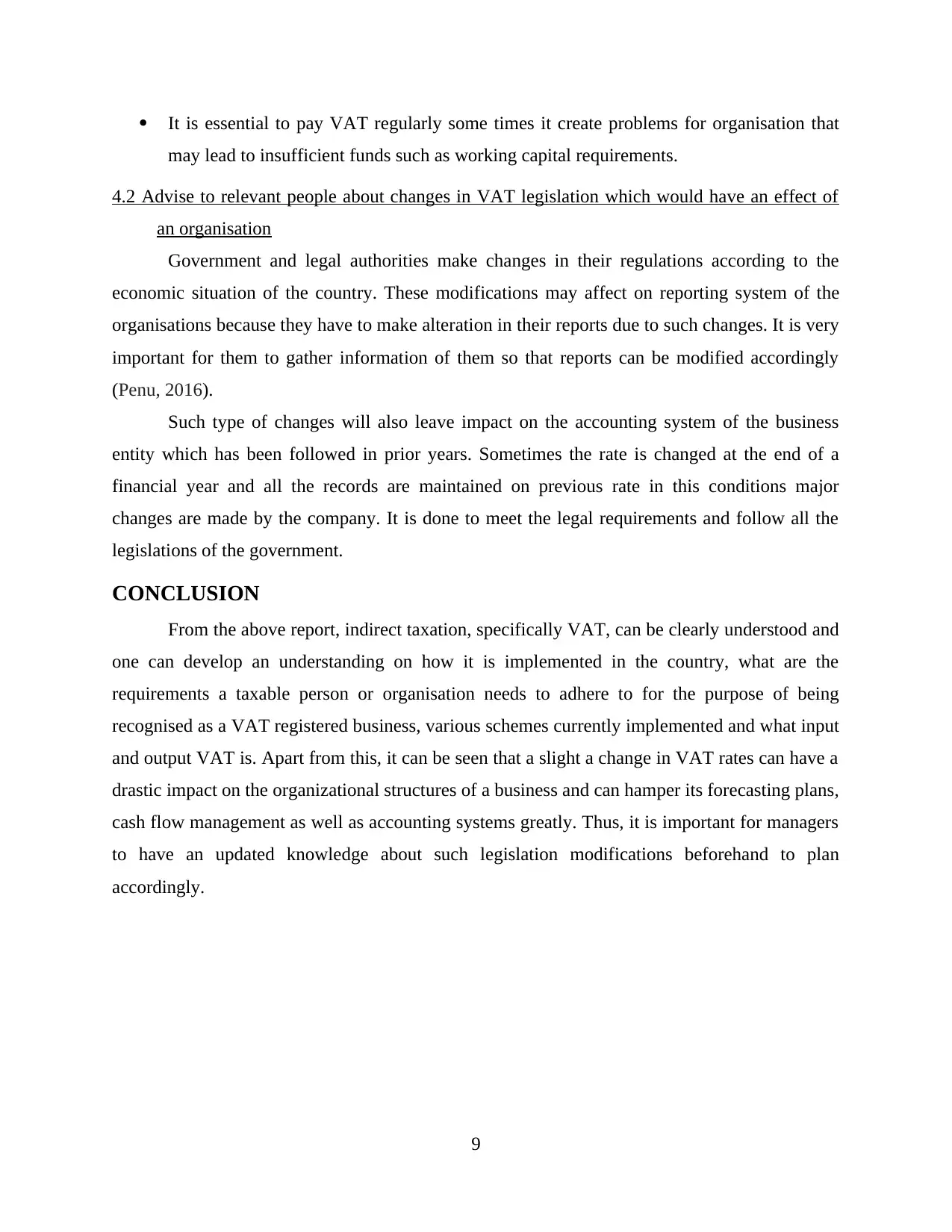
It is essential to pay VAT regularly some times it create problems for organisation that
may lead to insufficient funds such as working capital requirements.
4.2 Advise to relevant people about changes in VAT legislation which would have an effect of
an organisation
Government and legal authorities make changes in their regulations according to the
economic situation of the country. These modifications may affect on reporting system of the
organisations because they have to make alteration in their reports due to such changes. It is very
important for them to gather information of them so that reports can be modified accordingly
(Penu, 2016).
Such type of changes will also leave impact on the accounting system of the business
entity which has been followed in prior years. Sometimes the rate is changed at the end of a
financial year and all the records are maintained on previous rate in this conditions major
changes are made by the company. It is done to meet the legal requirements and follow all the
legislations of the government.
CONCLUSION
From the above report, indirect taxation, specifically VAT, can be clearly understood and
one can develop an understanding on how it is implemented in the country, what are the
requirements a taxable person or organisation needs to adhere to for the purpose of being
recognised as a VAT registered business, various schemes currently implemented and what input
and output VAT is. Apart from this, it can be seen that a slight a change in VAT rates can have a
drastic impact on the organizational structures of a business and can hamper its forecasting plans,
cash flow management as well as accounting systems greatly. Thus, it is important for managers
to have an updated knowledge about such legislation modifications beforehand to plan
accordingly.
9
may lead to insufficient funds such as working capital requirements.
4.2 Advise to relevant people about changes in VAT legislation which would have an effect of
an organisation
Government and legal authorities make changes in their regulations according to the
economic situation of the country. These modifications may affect on reporting system of the
organisations because they have to make alteration in their reports due to such changes. It is very
important for them to gather information of them so that reports can be modified accordingly
(Penu, 2016).
Such type of changes will also leave impact on the accounting system of the business
entity which has been followed in prior years. Sometimes the rate is changed at the end of a
financial year and all the records are maintained on previous rate in this conditions major
changes are made by the company. It is done to meet the legal requirements and follow all the
legislations of the government.
CONCLUSION
From the above report, indirect taxation, specifically VAT, can be clearly understood and
one can develop an understanding on how it is implemented in the country, what are the
requirements a taxable person or organisation needs to adhere to for the purpose of being
recognised as a VAT registered business, various schemes currently implemented and what input
and output VAT is. Apart from this, it can be seen that a slight a change in VAT rates can have a
drastic impact on the organizational structures of a business and can hamper its forecasting plans,
cash flow management as well as accounting systems greatly. Thus, it is important for managers
to have an updated knowledge about such legislation modifications beforehand to plan
accordingly.
9
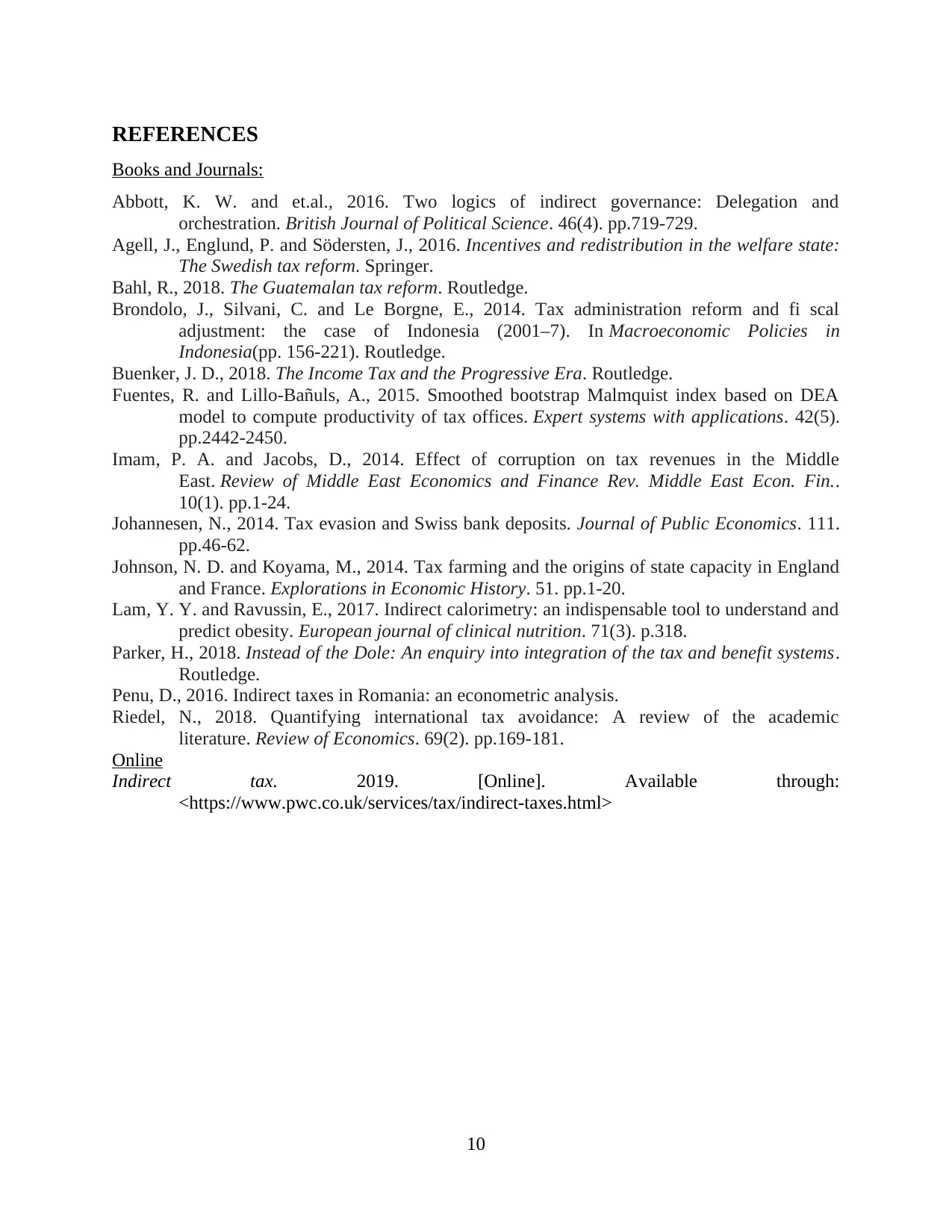
REFERENCES
Books and Journals:
Abbott, K. W. and et.al., 2016. Two logics of indirect governance: Delegation and
orchestration. British Journal of Political Science. 46(4). pp.719-729.
Agell, J., Englund, P. and Södersten, J., 2016. Incentives and redistribution in the welfare state:
The Swedish tax reform. Springer.
Bahl, R., 2018. The Guatemalan tax reform. Routledge.
Brondolo, J., Silvani, C. and Le Borgne, E., 2014. Tax administration reform and fi scal
adjustment: the case of Indonesia (2001–7). In Macroeconomic Policies in
Indonesia(pp. 156-221). Routledge.
Buenker, J. D., 2018. The Income Tax and the Progressive Era. Routledge.
Fuentes, R. and Lillo-Bañuls, A., 2015. Smoothed bootstrap Malmquist index based on DEA
model to compute productivity of tax offices. Expert systems with applications. 42(5).
pp.2442-2450.
Imam, P. A. and Jacobs, D., 2014. Effect of corruption on tax revenues in the Middle
East. Review of Middle East Economics and Finance Rev. Middle East Econ. Fin..
10(1). pp.1-24.
Johannesen, N., 2014. Tax evasion and Swiss bank deposits. Journal of Public Economics. 111.
pp.46-62.
Johnson, N. D. and Koyama, M., 2014. Tax farming and the origins of state capacity in England
and France. Explorations in Economic History. 51. pp.1-20.
Lam, Y. Y. and Ravussin, E., 2017. Indirect calorimetry: an indispensable tool to understand and
predict obesity. European journal of clinical nutrition. 71(3). p.318.
Parker, H., 2018. Instead of the Dole: An enquiry into integration of the tax and benefit systems.
Routledge.
Penu, D., 2016. Indirect taxes in Romania: an econometric analysis.
Riedel, N., 2018. Quantifying international tax avoidance: A review of the academic
literature. Review of Economics. 69(2). pp.169-181.
Online
Indirect tax. 2019. [Online]. Available through:
<https://www.pwc.co.uk/services/tax/indirect-taxes.html>
10
Books and Journals:
Abbott, K. W. and et.al., 2016. Two logics of indirect governance: Delegation and
orchestration. British Journal of Political Science. 46(4). pp.719-729.
Agell, J., Englund, P. and Södersten, J., 2016. Incentives and redistribution in the welfare state:
The Swedish tax reform. Springer.
Bahl, R., 2018. The Guatemalan tax reform. Routledge.
Brondolo, J., Silvani, C. and Le Borgne, E., 2014. Tax administration reform and fi scal
adjustment: the case of Indonesia (2001–7). In Macroeconomic Policies in
Indonesia(pp. 156-221). Routledge.
Buenker, J. D., 2018. The Income Tax and the Progressive Era. Routledge.
Fuentes, R. and Lillo-Bañuls, A., 2015. Smoothed bootstrap Malmquist index based on DEA
model to compute productivity of tax offices. Expert systems with applications. 42(5).
pp.2442-2450.
Imam, P. A. and Jacobs, D., 2014. Effect of corruption on tax revenues in the Middle
East. Review of Middle East Economics and Finance Rev. Middle East Econ. Fin..
10(1). pp.1-24.
Johannesen, N., 2014. Tax evasion and Swiss bank deposits. Journal of Public Economics. 111.
pp.46-62.
Johnson, N. D. and Koyama, M., 2014. Tax farming and the origins of state capacity in England
and France. Explorations in Economic History. 51. pp.1-20.
Lam, Y. Y. and Ravussin, E., 2017. Indirect calorimetry: an indispensable tool to understand and
predict obesity. European journal of clinical nutrition. 71(3). p.318.
Parker, H., 2018. Instead of the Dole: An enquiry into integration of the tax and benefit systems.
Routledge.
Penu, D., 2016. Indirect taxes in Romania: an econometric analysis.
Riedel, N., 2018. Quantifying international tax avoidance: A review of the academic
literature. Review of Economics. 69(2). pp.169-181.
Online
Indirect tax. 2019. [Online]. Available through:
<https://www.pwc.co.uk/services/tax/indirect-taxes.html>
10
⊘ This is a preview!⊘
Do you want full access?
Subscribe today to unlock all pages.

Trusted by 1+ million students worldwide
1 out of 12
Related Documents
Your All-in-One AI-Powered Toolkit for Academic Success.
+13062052269
info@desklib.com
Available 24*7 on WhatsApp / Email
![[object Object]](/_next/static/media/star-bottom.7253800d.svg)
Unlock your academic potential
Copyright © 2020–2025 A2Z Services. All Rights Reserved. Developed and managed by ZUCOL.





